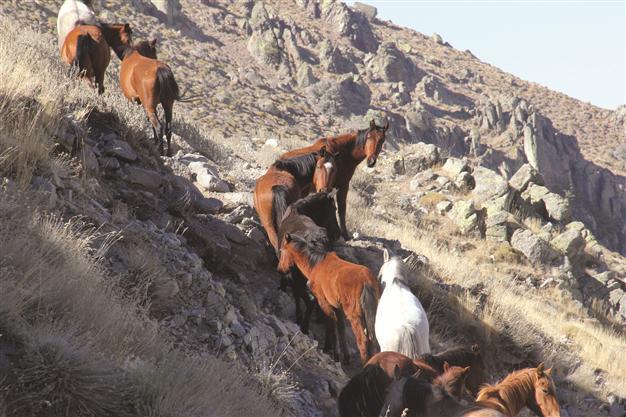Abandoned yılkı horses now symbol of Karadağ
KARAMAN - Anadolu Agency

The horses, which are living in herds in Karadağ, have been abandoned by villagers and have become wild over time.
Yılkı horses, horses abandoned and turned loose by their owners, are now symbols of the central Anatolian city of Karaman, specifically around the Karadağ region.
Karadağ, which is an inactive volcano in the middle of a plain in the Kılbasan district, is home to hundreds of cultural and natural beauties. It is possible to see the traces of life from the past all around the volcano. Among them are historic cisterns, Hittite inscriptions, as well as pools, military structures and the remains of a Roman church.
The natural life and endemic plants in the mountain draw the attention of researchers and nature lovers. One can see many types of species such as partridges, rabbits, wolves, mountain sheep, snakes and jade horses.
The number of these yılkı horses reaches toward the 600’s and they have an interesting story. The horses, which are living in herds in Karadağ, have been abandoned by villagers and have become wild over time.
‘They are not abandoned’A villager, Murat Tanrıverdi, said the horses were not abandoned, but owned by people living in villages in the area. He said all tasks in the village were done with horses by the villagers 40-50 years ago and continued, “Machines and tractors did not exist at that time. We used to plow and harvest our products with these horses. And we also used to carry our loads on these horses. When the fall came and field tasks were complete, the horses were left in the mountains. They stayed in the mountain until the spring and were caught by their owners again when the spring came.”
Tanrıverdi said need decreased for the horses as tractors became widespread and some villagers sold their horses to buy tractors. “In this way, the horses became wild in nature and began living in herds,” he said and continued, “These horses stay in the mountain throughout the year. Karadağ is rich in terms of flora. They eat dried plants and gum tragacanth, which is very useful for animals. When they eat this plant, they don’t get cold. They also eat oak as well as the fruit of the trees.”
They are under protection
Tanrıverdi said the villagers did not welcome the increase in the number of horses because they said the horses damaged the plantation. He said the horses were under protection adding, “The state leaves water for the horses in the summer months. If snowfall is too strong, food is left in certain places in the mountain. Sometimes we hear that hunters shoot these animals or they are caught and sold. It makes us very sad. We are very pleased when we see that they are free.”
In the past, people came to Karadağ to see historic remains, according to Tanrıverdi. “But now everyone visiting Karadağ wants to see the yılkı horses. Turkish and foreign tourists and journalists come to the city. Yılkı horses are an unchangeable symbol of Karadağ,” he said.
